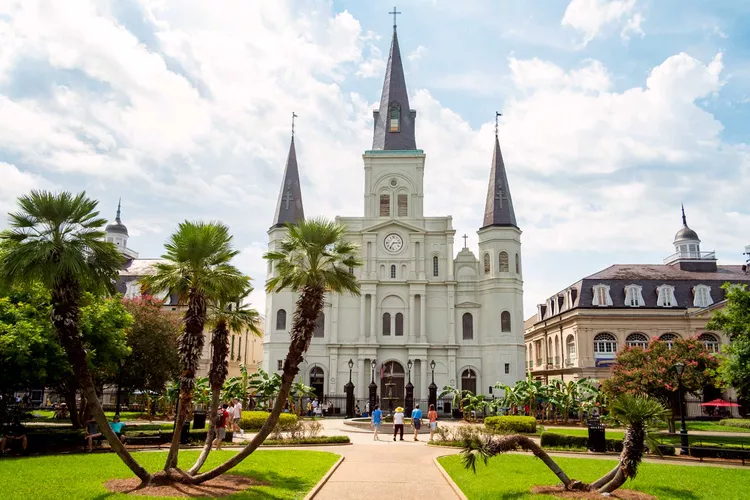Discover the Rich History of New Orleans
If you’re looking for history, you’ve come to the right place.
New Orleans is deeply complex, with intermingled layers of cultures, cuisines, and histories. Rightly so, as it is a 304-year-old city, first colonized by the French in 1718. While the history of the land and people who occupied it go further back than 1718 (notably by the Chitimacha and Chahta-Yakni (Choctaw) Indigenous peoples), the visible history of today starts in the mid-18th-century with those early French and Spanish colonies.
The French Quarter buildings are exemplary representations of Creole Architecture — a mix of Spanish, French, and Caribbean influence, designed to withstand the hot and humid climate. Strolling the busy streets of the quarter, you can see this history in the weathered facades and layers of paint and the tediously handmade, lavishly decorated terrace railings. It’s all a part of the city’s allure, best seen through a local walking tour. Want to see it all on your own time? Here are a few of the oldest buildings in New Orleans that are worthy of seeing both inside and out on your own personalized historical journey.
Old Ursuline Convent Museum, 1745

The Old Ursuline Convent Museum is the oldest building in the Mississippi Valley and the most exquisite surviving example of French Colonial public architecture. A formal front garden greets guests, but step inside to see the handcrafted cypress stairwell and handmade railing to really be left in awe. Tours of the museum also cover the religious histories of the nuns who originally occupied the convent grounds and their contributions to early New Orleans.
To visit: stlouiscathedral.org
Napoleon’s House, 1794

This inconspicuous gray corner building was once the home to Nicholas Girod, who served as the first mayor for New Orleans after Louisiana became an official state. As for how the building got its name, Girod allegedly offered it to Napoleon in 1821 as a refuge during his exile. Over the years, the building changed hands, becoming a grocery store before the Impastato family took over and ran it as a restaurant, which it remains today. Executive chef Chris Montero continues the work of the Impastato family with a few time-honored traditional menu items, which you can try at one of the tables or the original wooden bar.
To visit: napoleonhouse.com
Brennan’s, 1795

The building on Royal Street was erected in 1795, first serving as a bank (the Louisiana State Bank, to be exact) before being leased to and then purchased by Owen Brennan in 1946. Brennan turned the spot into the sensational French fine dining restaurant, which it also remains today. Be enchanted by the pink facade and dine inside for a family breakfast, and don’t skip the bananas fosters and eggs hussarde.
For reservations: brennansneworleans.com
Preservation Hall, 1817

Preservation Hall is likely a name you’ve heard before if you’re a jazz fan. The music venue, located on St. Peter Street, is the spot to be for intimate performances, but don’t forget to look around a bit while you’re there to really see the building. Housed inside a one-time Creole townhouse built in the 19th century, it became a popular music hall in the 1950s and has more than stood the test of time. During the Jim Crow era, the hall was an especially rare place in the South to come together with integrated audiences and musicians to listen to jazz. The current owners remain committed to giving jazz musicians a space to perform 350 nights a year.
To visit: preservationhall.com
U.S. Mint, 1838

The New Orleans Mint began operating in March of 1838, when the city was home to the largest amount of foreign trade in the United States. Today, it’s home to the New Orleans Jazz Museum — an absolute must-visit destination in the city. The museum contains engaging exhibits on the history and modern-day culture of jazz and other essential music genres native to New Orleans. There remains a small section showing the inner workings and history of the building’s operation as a mint for interested coin aficionados.
To Visit: nolajazzmuseum.org
Gallier House, 1857

James Gallier, Jr., a prominent New Orleans architect, built this upper-middle-class 19th-century home between 1857 and 1860 for his wife and daughters. The exterior features Italianate and classical styles with a signature Parisian green paint color on the front gates. The engineering innovations used throughout the home make the house even more attractive. Gallier was one of the first to incorporate modern amenities like copper plumbing, a double skylight, and a ventilation system in the primary bedroom. In the summer, the house is dressed with white linen furniture coverings, nettings over gold finishes, and painted window shades to endure the heat. The tours here do not skip over its history, speaking to the enslaved individuals who spent their lives under the family.
To visit: hgghh.org





